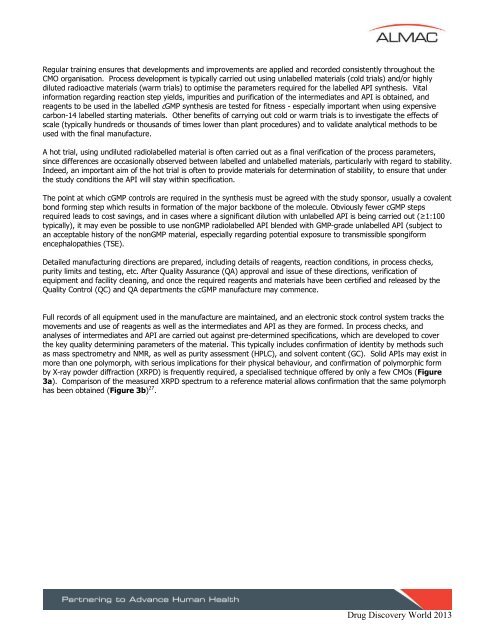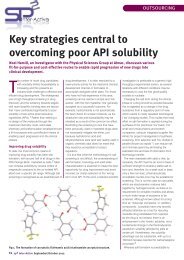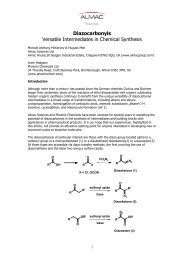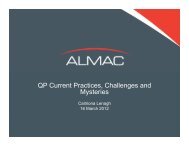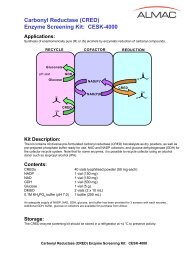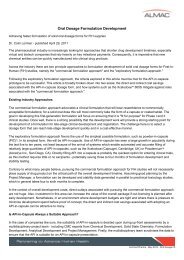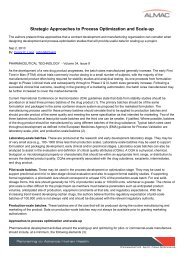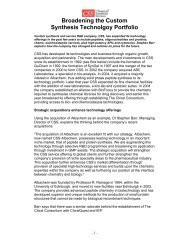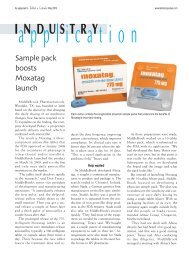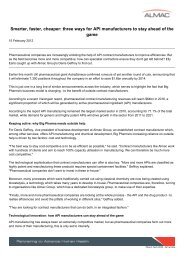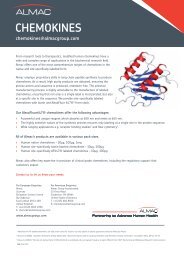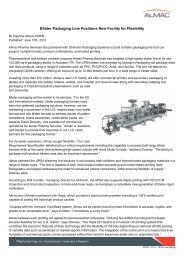CARBON-14 LABELLED API MANUFACTURING - Almac
CARBON-14 LABELLED API MANUFACTURING - Almac
CARBON-14 LABELLED API MANUFACTURING - Almac
Create successful ePaper yourself
Turn your PDF publications into a flip-book with our unique Google optimized e-Paper software.
Regular training ensures that developments and improvements are applied and recorded consistently throughout the<br />
CMO organisation. Process development is typically carried out using unlabelled materials (cold trials) and/or highly<br />
diluted radioactive materials (warm trials) to optimise the parameters required for the labelled <strong>API</strong> synthesis. Vital<br />
information regarding reaction step yields, impurities and purification of the intermediates and <strong>API</strong> is obtained, and<br />
reagents to be used in the labelled cGMP synthesis are tested for fitness - especially important when using expensive<br />
carbon-<strong>14</strong> labelled starting materials. Other benefits of carrying out cold or warm trials is to investigate the effects of<br />
scale (typically hundreds or thousands of times lower than plant procedures) and to validate analytical methods to be<br />
used with the final manufacture.<br />
A hot trial, using undiluted radiolabelled material is often carried out as a final verification of the process parameters,<br />
since differences are occasionally observed between labelled and unlabelled materials, particularly with regard to stability.<br />
Indeed, an important aim of the hot trial is often to provide materials for determination of stability, to ensure that under<br />
the study conditions the <strong>API</strong> will stay within specification.<br />
The point at which cGMP controls are required in the synthesis must be agreed with the study sponsor, usually a covalent<br />
bond forming step which results in formation of the major backbone of the molecule. Obviously fewer cGMP steps<br />
required leads to cost savings, and in cases where a significant dilution with unlabelled <strong>API</strong> is being carried out (≥1:100<br />
typically), it may even be possible to use nonGMP radiolabelled <strong>API</strong> blended with GMP-grade unlabelled <strong>API</strong> (subject to<br />
an acceptable history of the nonGMP material, especially regarding potential exposure to transmissible spongiform<br />
encephalopathies (TSE).<br />
Detailed manufacturing directions are prepared, including details of reagents, reaction conditions, in process checks,<br />
purity limits and testing, etc. After Quality Assurance (QA) approval and issue of these directions, verification of<br />
equipment and facility cleaning, and once the required reagents and materials have been certified and released by the<br />
Quality Control (QC) and QA departments the cGMP manufacture may commence.<br />
Full records of all equipment used in the manufacture are maintained, and an electronic stock control system tracks the<br />
movements and use of reagents as well as the intermediates and <strong>API</strong> as they are formed. In process checks, and<br />
analyses of intermediates and <strong>API</strong> are carried out against pre-determined specifications, which are developed to cover<br />
the key quality determining parameters of the material. This typically includes confirmation of identity by methods such<br />
as mass spectrometry and NMR, as well as purity assessment (HPLC), and solvent content (GC). Solid <strong>API</strong>s may exist in<br />
more than one polymorph, with serious implications for their physical behaviour, and confirmation of polymorphic form<br />
by X-ray powder diffraction (XRPD) is frequently required, a specialised technique offered by only a few CMOs (Figure<br />
3a). Comparison of the measured XRPD spectrum to a reference material allows confirmation that the same polymorph<br />
has been obtained (Figure 3b) 27 .<br />
Drug Discovery World 2013


